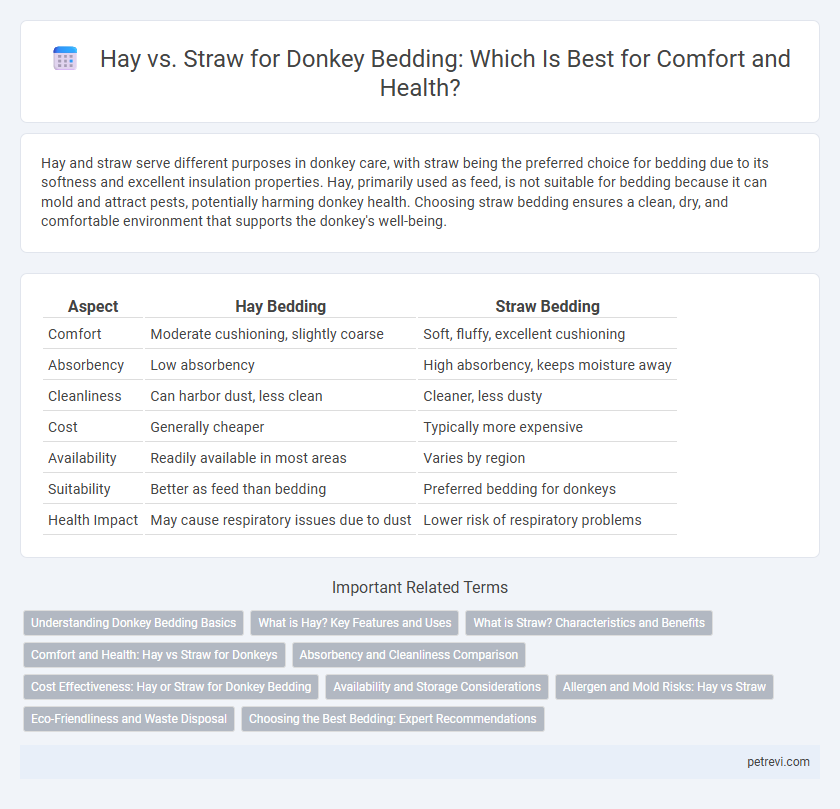Hay and straw serve different purposes in donkey care, with straw being the preferred choice for bedding due to its softness and excellent insulation properties. Hay, primarily used as feed, is not suitable for bedding because it can mold and attract pests, potentially harming donkey health. Choosing straw bedding ensures a clean, dry, and comfortable environment that supports the donkey's well-being.
Table of Comparison
| Aspect | Hay Bedding | Straw Bedding |
|---|---|---|
| Comfort | Moderate cushioning, slightly coarse | Soft, fluffy, excellent cushioning |
| Absorbency | Low absorbency | High absorbency, keeps moisture away |
| Cleanliness | Can harbor dust, less clean | Cleaner, less dusty |
| Cost | Generally cheaper | Typically more expensive |
| Availability | Readily available in most areas | Varies by region |
| Suitability | Better as feed than bedding | Preferred bedding for donkeys |
| Health Impact | May cause respiratory issues due to dust | Lower risk of respiratory problems |
Understanding Donkey Bedding Basics
Hay provides a soft and absorbent bedding option for donkeys, offering added nutritional value if ingested. Straw is commonly used due to its affordability and good insulation properties, but it absorbs moisture less effectively, potentially increasing the risk of respiratory issues. Choosing between hay and straw depends on balancing comfort, hygiene, and cost for optimal donkey welfare.
What is Hay? Key Features and Uses
Hay is dried grass or legumes harvested and stored primarily as animal fodder, containing high fiber essential for donkey digestion. Its key features include nutrient richness, palatability, and moisture content typically around 15%, which supports digestive health and prevents respiratory issues in donkeys. Commonly used as both feed and bedding, hay provides a softer, more absorbent layer compared to straw, promoting comfort and hygiene in donkey stables.
What is Straw? Characteristics and Benefits
Straw is the dry stalks of cereal plants such as wheat, barley, or oats after the grain and chaff have been removed. It is lightweight, highly absorbent, and provides excellent insulation, making it a comfortable and warm bedding choice for donkeys. Its natural structure helps keep donkeys dry by wicking moisture away, reducing the risk of respiratory issues and hoof problems.
Comfort and Health: Hay vs Straw for Donkeys
Hay provides superior cushioning and absorbs moisture effectively, enhancing comfort and preventing skin irritations in donkeys. Straw offers good insulation but tends to retain moisture, increasing the risk of respiratory issues and infections. Choosing hay as bedding supports better hygiene and overall donkey health through improved comfort and reduced pathogen exposure.
Absorbency and Cleanliness Comparison
Hay and straw differ significantly in absorbency and cleanliness for donkey bedding. Straw's coarse structure offers moderate absorbency but tends to hold dirt and moisture longer, increasing the risk of bacterial growth. Hay, while softer and more absorbent, can retain moisture effectively, promoting a cleaner, drier environment that reduces odors and improves donkey hoof health.
Cost Effectiveness: Hay or Straw for Donkey Bedding
Straw proves more cost-effective for donkey bedding due to its lower price per bale and longer-lasting absorbency compared to hay. While hay is primarily used for feeding, its higher nutritional value and cost make it less suitable and economical for bedding purposes. Choosing straw reduces overall expenses while providing adequate comfort and insulation for donkeys.
Availability and Storage Considerations
Hay and straw differ significantly in availability and storage needs when used for donkey bedding. Straw is often more readily accessible as a byproduct of cereal crop harvesting, while hay, primarily intended as animal feed, can be less abundant and more costly. Straw requires dry, well-ventilated storage to prevent mold and maintain its cushioning qualities, whereas hay demands tightly controlled conditions to avoid moisture and nutrient degradation.
Allergen and Mold Risks: Hay vs Straw
Straw bedding poses lower allergen risks for donkeys compared to hay, which often contains pollen and dust that can trigger respiratory issues. Mold growth is more prevalent in damp hay due to its higher moisture content, increasing the risk of respiratory problems and infections in donkeys. Choosing dry, clean straw reduces exposure to allergens and mold, promoting better respiratory health for donkeys.
Eco-Friendliness and Waste Disposal
Straw is often favored for donkey bedding due to its high biodegradability and ease of composting, making it an eco-friendly choice that reduces landfill waste. Hay, while providing some cushioning, tends to compact and retain moisture, leading to less efficient decomposition and potential odor issues. Choosing straw supports sustainable waste disposal by promoting natural breakdown and minimizing environmental impact.
Choosing the Best Bedding: Expert Recommendations
Hay and straw differ significantly in absorbency and comfort for donkey bedding, with straw being favored for its superior moisture-wicking properties. Experts recommend straw as the best bedding choice due to its ability to keep donkeys dry and reduce the risk of hoof diseases. While hay is primarily a feed source, straw provides a soft, insulating layer ideal for maintaining optimal hygiene in donkey stables.
Hay vs Straw for Donkey Bedding Infographic

 petrevi.com
petrevi.com